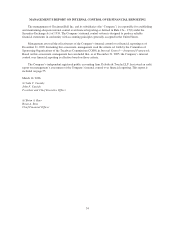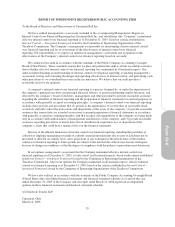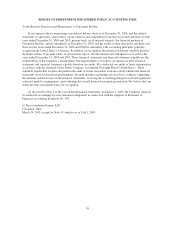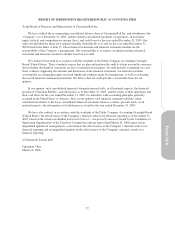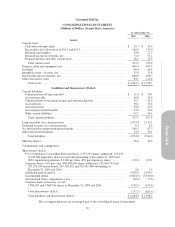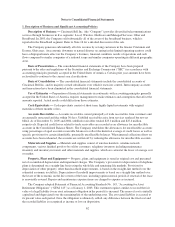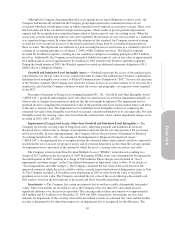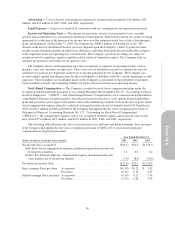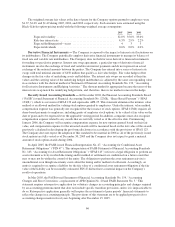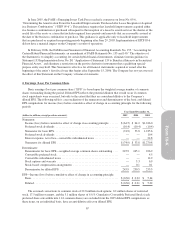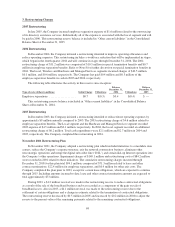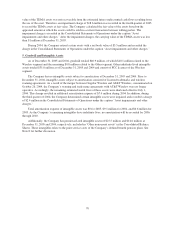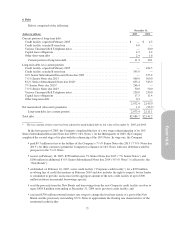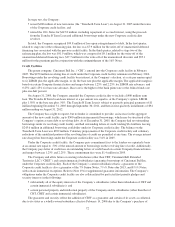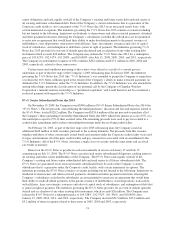Cincinnati Bell 2005 Annual Report Download - page 114
Download and view the complete annual report
Please find page 114 of the 2005 Cincinnati Bell annual report below. You can navigate through the pages in the report by either clicking on the pages listed below, or by using the keyword search tool below to find specific information within the annual report.Company estimates fair value using external information and discounted cash flow analyses. In 2003, the
Company received $3.8 million from the sale of an investment. During 2004, the Company received a return on
capital on an investment and recorded $3.2 million in the Consolidated Statements of Operations under the
heading “Other income, net.”
Revenue Recognition — The Company recognizes revenue as services are provided. Local and special
access fees, which are billed monthly, and prepaid wireless receipts are collected in advance, but the revenue is
not recognized until the service is provided. Postpaid wireless, long distance, switched access, data center
management services, reciprocal compensation, and data and Internet product services are billed monthly in
arrears. The Company bills service revenue in regular monthly cycles, which are dispersed throughout the days
of the month. As the day of each billing cycle rarely coincides with the end of the Company’s reporting period
for usage-based services such as postpaid wireless, long distance, and switched access, the Company must
estimate service revenues earned but not yet billed. The Company bases its estimates upon historical usage and
adjusts these estimates during the period in which the Company can determine actual usage, typically in the
following reporting period.
Cincinnati Bell Telephone Company LLC (“CBT”) advanced billings for customer connection and
activation are deferred and amortized into revenue on a straight-line basis over the average customer life. The
associated connection and activation costs, to the extent of the upfront fees, are also deferred and amortized on a
straight-line basis over the average customer life. Subsequent to July 1, 2003 and in accordance with the
Emerging Issues Task Force Issue 00-21, “Accounting for Revenue Arrangements with Multiple Deliverables”
(“EITF 00-21”), Cincinnati Bell Wireless LLC (“CBW”) ceased deferral of revenue and cost related to customer
connections and activations. As CBW’s activation costs exceed activation revenues, both the activation revenue
and associated costs are recorded upon the sale of the wireless handset. This change did not have a material
impact on the Company’s financial position, results of operations, or cash flows.
With respect to arrangements with multiple deliverables, the Company follows the guidance in EITF 00-21
to determine whether more than one unit of accounting exists in an arrangement. To the extent that the
deliverables are separable into multiple units of accounting, total consideration is allocated to the individual units
of accounting based on their relative fair value, determined by the price of each deliverable when it is regularly
sold on a stand-alone basis. Revenue is recognized for each unit of accounting as delivered or as service is
performed depending on the nature of the deliverable comprising the unit of accounting.
The Company recognizes equipment revenue generally upon the performance of contractual obligations,
such as shipment, delivery, installation or customer acceptance. The Company is a reseller of IT and telephony
equipment and considers the criteria of EITF 99-19, “Reporting Revenue Gross as a Principal versus Net as an
Agent,” when recording revenue, such as title transfer, risk of product loss, and collection risk. Based on this
guidance, these equipment revenues and associated costs have generally been recorded on a gross basis, rather
than recording the revenues net of the associated costs.
Prior to the sale of the broadband assets in 2003, broadband transport services were billed monthly, in
advance, while revenue was recognized as the services were provided. In addition, the Company had entered into
indefeasible right-of-use (“IRU”) agreements, which represent the lease of network capacity or dark fiber,
recording unearned revenue at the earlier of the acceptance of the applicable portion of the network by the
customer or the receipt of cash. The buyer of IRU services typically paid cash or other consideration upon
execution of the contract, and the associated IRU revenue was recognized over the life of the agreement as
services were provided, beginning on the date of customer acceptance. In the event the buyer of an IRU
terminated a contract prior to the contract expiration and released the Company from the obligation to provide
future services, the remaining unamortized unearned revenue was recognized in the period in which the contract
was terminated. The Company generated $59.4 million in non-cash IRU revenue in 2003. Concurrent with the
broadband asset sale in 2003, substantially all of the remaining IRU obligations were assumed by the buyer of the
broadband assets.
Pricing of local services is generally subject to oversight by both state and federal regulatory commissions.
Such regulation also covers services, competition and other public policy issues. Various regulatory rulings and
interpretations could result in adjustments to revenue in future periods. The Company monitors these proceedings
closely and adjusts revenue accordingly.
64


